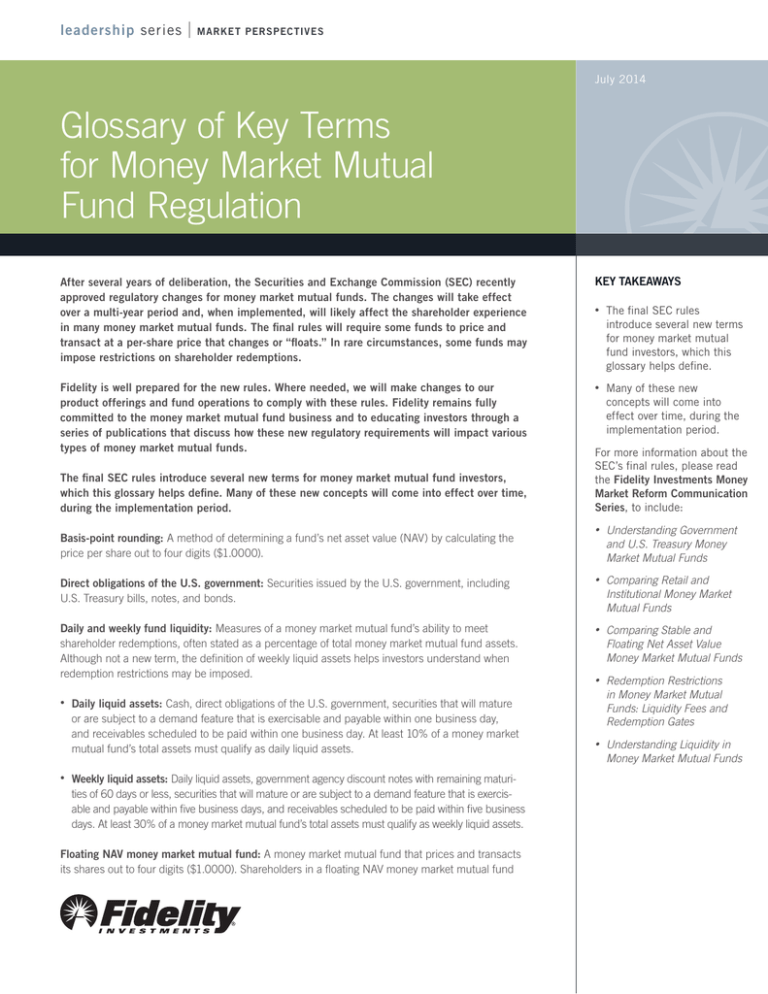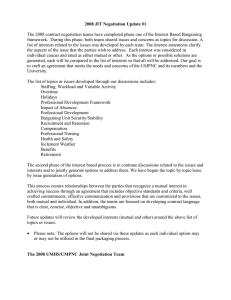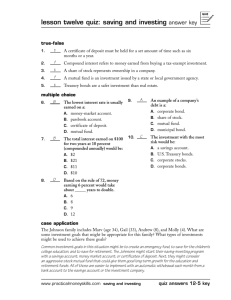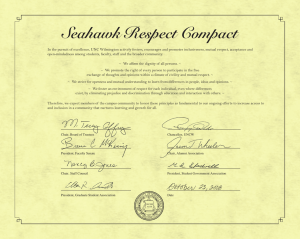
leadership series
MARKET PERSPECTIVES
July 2014
Glossary of Key Terms
for Money Market Mutual
Fund Regulation
After several years of deliberation, the Securities and Exchange Commission (SEC) recently
approved regulatory changes for money market mutual funds. The changes will take effect
over a multi-year period and, when implemented, will likely affect the shareholder experience
in many money market mutual funds. The final rules will require some funds to price and
transact at a per-share price that changes or “floats.” In rare circumstances, some funds may
impose restrictions on shareholder redemptions.
KEY TAKEAWAYS
•
The final SEC rules
introduce several new terms
for money market mutual
fund investors, which this
glossary helps define.
Fidelity is well prepared for the new rules. Where needed, we will make changes to our
product offerings and fund operations to comply with these rules. Fidelity remains fully
committed to the money market mutual fund business and to educating investors through a
series of publications that discuss how these new regulatory requirements will impact various
types of money market mutual funds.
•
Many of these new
concepts will come into
effect over time, during the
implementation period.
The final SEC rules introduce several new terms for money market mutual fund investors,
which this glossary helps define. Many of these new concepts will come into effect over time,
during the implementation period.
For more information about the
SEC’s final rules, please read
the Fidelity Investments Money
Market Reform Communication
Series, to include:
•
Understanding Government
and U.S. Treasury Money
Market Mutual Funds
Direct obligations of the U.S. government: Securities issued by the U.S. government, including
U.S. Treasury bills, notes, and bonds.
•
Comparing Retail and
Institutional Money Market
Mutual Funds
Daily and weekly fund liquidity: Measures of a money market mutual fund’s ability to meet
shareholder redemptions, often stated as a percentage of total money market mutual fund assets.
Although not a new term, the definition of weekly liquid assets helps investors understand when
redemption restrictions may be imposed.
•
Comparing Stable and
Floating Net Asset Value
Money Market Mutual Funds
•
Redemption Restrictions
in Money Market Mutual
Funds: Liquidity Fees and
Redemption Gates
•
Understanding Liquidity in
Money Market Mutual Funds
Basis-point rounding: A method of determining a fund’s net asset value (NAV) by calculating the
price per share out to four digits ($1.0000).
•
•
Daily liquid assets: Cash, direct obligations of the U.S. government, securities that will mature
or are subject to a demand feature that is exercisable and payable within one business day,
and receivables scheduled to be paid within one business day. At least 10% of a money market
mutual fund’s total assets must qualify as daily liquid assets.
Weekly liquid assets: Daily liquid assets, government agency discount notes with remaining maturities of 60 days or less, securities that will mature or are subject to a demand feature that is exercisable and payable within five business days, and receivables scheduled to be paid within five business
days. At least 30% of a money market mutual fund’s total assets must qualify as weekly liquid assets.
Floating NAV money market mutual fund: A money market mutual fund that prices and transacts
its shares out to four digits ($1.0000). Shareholders in a floating NAV money market mutual fund
may experience a gain or loss if the per-share value of the fund
changes by 1/100th of a penny (also known as a basis point).
For example, if a shareholder owned 10,000 shares priced at
$1.0000, a 1 basis point change in a floating NAV fund would
result in a gain or loss of $1.00.
Government agencies: Organizations established to conduct
specific government business. Securities issued by U.S.
government agencies, unlike U.S. Treasuries, are not generally
backed by the full faith and credit of the U.S. government.
Government money market mutual fund: Under the new rules,
a money market mutual fund that invests 99.5% of its total
assets in cash, government securities, or repurchase agreements
collateralized by government securities. A government money
market mutual fund is eligible to price and transact using a stable
$1.00 NAV, and is not subject to liquidity fees and redemption
gates. A U.S. Treasury and U.S. Treasury Only money market
mutual fund will fall under this definition.
Institutional money market mutual fund: A money market
mutual fund that does not qualify as a retail money market mutual
fund, under the new rules. An institutional fund will not limit
shareholders to beneficial ownership by “natural persons” (i.e.,
individuals, or human beings). Institutional fund shareholders
may include individuals, small businesses, or large corporations.
Liquidity fee: A redemption restriction that permits a money market
mutual fund’s board to impose a fee of up to 2% on shareholder
redemptions if a fund’s weekly liquid assets were to fall below
30%. If weekly liquid assets were to fall below 10%, a fund would
be required to impose a 1% liquidity fee unless the fund’s board
determines that a fee is not in the best interests of the fund. The
fee would be removed when weekly liquid assets return to 30% or
when the fund’s board determines a liquidity fee is no longer in the
best interests of the fund. All fees would be payable to the fund.
governments, colleges, hospitals, universities, and other nonprofit
entities, and that seeks to generate federally tax-exempt income.
Prime money market mutual fund (general purpose): A
money market mutual fund that invests primarily in any eligible
high-quality money market instrument as defined by SEC
regulations, including U.S. government securities, commercial
paper, certificates of deposit, corporate notes, and other debt
investments. A prime money market mutual fund is also known
as a general purpose money market mutual fund.
Redemption gate: A redemption restriction that permits a money
market mutual fund’s board to halt all shareholder withdrawals for
up to 10 days if a fund’s weekly liquid assets were to fall below
30%. The gate would be lifted when weekly liquid assets return to
30% or when the fund’s board determines a redemption gate is
no longer in the best interests of the fund.
Retail money market mutual fund: A money market mutual
fund that limits all beneficial owners of the fund to natural persons.
Stable NAV money market mutual fund: A money market mutual
fund that seeks to maintain a constant $1.00 NAV.
U.S. Treasury money market mutual fund: A money market
mutual fund that invests in cash, U.S. Treasury securities or
repurchase agreements collateralized by U.S. Treasury securities.
Because a U.S. Treasury fund will qualify as a government money
market mutual fund, a U.S. Treasury money market mutual fund is
eligible to price and transact using a stable $1.00 NAV, and is not
subject to liquidity fees and redemption gates.
Municipal money market mutual fund: A money market mutual
fund that invests primarily in securities issued by state and local
U.S. Treasury Only money market mutual fund: A money
market mutual fund that invests only in direct obligations of the
U.S. Treasury. Because a U.S. Treasury Only fund will qualify as
a government money market mutual fund, a U.S. Treasury Only
money market mutual fund is eligible to price and transact using
a stable $1.00 NAV and is not subject to liquidity fees and
redemption gates.
Before investing, consider the funds’ investment objectives,
risks, charges, and expenses. Contact Fidelity or visit advisor.
fidelity.com for a prospectus or, if available, a summary
prospectus containing this information. Read it carefully.
Asset Management (FIAM), this publication is provided to investment
professionals, plan sponsors, institutional investors, and individual
investors by Fidelity Investments Institutional Services Company, Inc.,
and for certain institutional investors by Pyramis Distributors Corporation
LLC.
You could lose money by investing in a money market fund. Although the
fund seeks to preserve the value of your investment at $1.00 per share,
it cannot guarantee it will do so. An investment in the fund is not insured
or guaranteed by the Federal Deposit Insurance Corporation or any other
government agency. Fidelity Investments and its affiliates, the fund’s
sponsor, have no legal obligation to provide financial support to the fund,
and you should not expect that the sponsor will provide financial support
to the fund at any time.
Third-party marks are the property of their respective owners; all other
marks are the property of FMR LLC.
2 If receiving this piece through your relationship with Fidelity Institutional
If receiving this piece through your relationship with Fidelity Personal
& Workplace Investing (PWI), Fidelity Family Office Services (FFOS), or
Fidelity Institutional Wealth Services (IWS), this publication is provided
through Fidelity Brokerage Services LLC, Member NYSE, SIPC.
If receiving this piece through your relationship with National Financial
or Fidelity Capital Markets, this publication is for institutional investor
use only. Clearing and custody services are provided through National
Financial Services LLC, Member NYSE, SIPC.
694186.3.0
© 2014 FMR LLC. All rights reserved.







